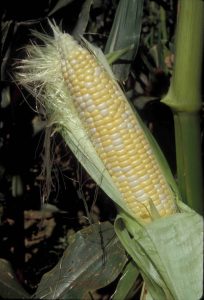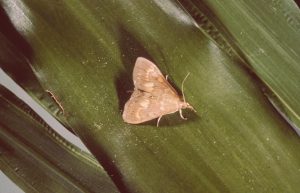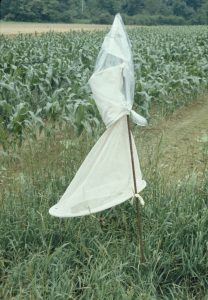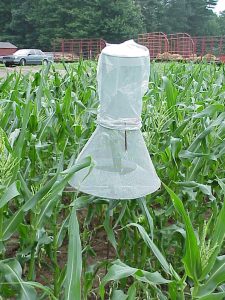Sweet Corn IPM Newsletter No. 1 – July 12, 2019

Sweet Corn IPM Newsletter No. 1 – July 12, 2019
Click on photos to enlarge.
2019 SWEET CORN PEST SEASON BEGINS!
European Corn Borer, Corn Earworm Active in Early Fields
Highmoor Farm Field Day
For Fruit and Vegetable Growers
Monmouth, Maine
Wednesday, July 31 from 2:30 p.m. to 7:30 p.m.
Preregister now!
The 2019 University of Maine Cooperative Extension Integrated Pest Management (IPM) program for sweet corn is underway. More than twenty volunteer farms are serving as pest monitoring and demonstration sites, with fields in North Berwick, Wells, Dayton, Cape Elizabeth, New Gloucester, Poland Spring, Auburn, Lewiston, Sabattus, Nobleboro, Monmouth, Wayne, Oxford, Farmington, Levant, Stillwater, Garland and East Corinth. We have set up pheromone traps at these locations to monitor the adult (moth) stages of European corn borer, corn earworm and fall armyworm, and we are scouting the fields for feeding injury by insect larvae. We’ll share the information we collect along with management recommendations through this newsletter blog. If you would prefer to receive this newsletter via e-mail, give us a call at 207.933.2100 or send an e-mail message to: pamela.stpeter@maine.edu.
SITUATION
Corn growers who were fortunate enough to get some early corn seeded before all the rain came this spring have corn in the pre-tassel to tasseling stage, with a few fields started under plastic or transplanted now in silk. Prolonged wet, cool weather slowed seeding later in the spring, so many farms have a noticeable gap between the earliest corn and the second planting. Our early scouting has shown both European corn borer activity in pre-tassel corn, and a few corn earworm in several locations. At this time corn earworm is only a concern in fields where there is early silking corn. Continued warm temperatures will likely increase insect activity in the coming days, and weather coming up from the south may also bring more corn earworm and the first fall armyworm of the season.
- European Corn Borer Moth; photo by David Handley
- European Corn Borer Trap; photo by David Handley
European corn borer: Pheromone traps for moths are set up in the grassy borders around cornfields. We have found early larval feeding damage at all of the locations we scouted this week. To monitor corn borer feeding, we examine 100 corn plants in each field, typically twenty plants in a row at five different locations. This provides a good estimate of the total amount of injury in a field.
In the early stages, European corn borer feeding damage looks like small “pinholes” in the leaves. Whorl stage corn only needs to be sprayed if fresh feeding injury is found on 30% or more of the plants scouted in a field. Once the corn reaches the pre-tassel stage, the control threshold is lowered to 15% because larvae feeding on the later stages are more likely to move into the ears. On the tassels, feeding damage first appears as chewing and brown waste found in the small florets. After the tassel has emerged from the whorl, the larvae chew into the stalk just below it, often causing the tassel to fall over. Sprays during the pre-tassel stage, when both moths and larvae are present, target the larvae before they can move into the protection of the stalks and ears. Good spray coverage of the entire plant provides the most effective kill of larvae as they move from one part of the plant to another. Rotating the type of insecticide used also improves control. Materials registered for controlling European corn borer include Bacillus thuringiensis products (XenTari®, Dipel DF®), Avaunt®, Coragen®, Warrior®, Lannate®, Baythroid®, Asana®, Radiant®, Delta Gold®, Mustang®, Sevin XLR® and Intrepid®. Newly hatched European corn borer larvae are very small and translucent with shiny black heads. They emerge from small egg masses that look like a tiny clump of overlapping fish scales on the undersides of corn leaves. European corn borer overwinters in Maine, and is usually the first pest to become a significant problem.
Growers should start scouting whorl to pre-tassel stage corn for feeding injury now. Once corn reaches the silk stage, sprays may be based on the number of corn borer moths caught in pheromone traps rather than feeding injury. European corn borer moths will lay eggs on flag leaves of silking corn, and the larvae can move into the ears without leaving visible feeding injury that would be noticed when scouting. If more than five moths are caught during a week in a field with silking corn, a spray is recommended. Varieties of corn genetically modified to produce the Bt toxin (e.g. Bt corn, Attribute® varieties), should not need to be sprayed to control European corn borer.
- Corn Earworm Moth; photo by David Handley
- Harstack Trap; photo by David Handley
Corn earworm: We have set up pheromone traps around the state for corn earworm moths. Corn earworm generally appears in Maine in early July, but the actual date varies greatly. The arrival of this pest is only a concern for fields with corn in the silk stage. Fields not yet in silk do not need to be protected from corn earworm. When corn earworm moths are caught at a site, all silking corn in the fields should be protected with a spray. These moths lay eggs on the fresh silks, and the larvae move directly into the ears of corn. When corn earworm moths cannot find silking corn to deposit their eggs on, they may lay eggs on the leaves or tassels of younger corn. The larvae will feed on the foliage and tassels, similar to armyworm, until the ears become available. When larvae are found feeding on younger corn, the damage is accounted for, along with any borer or armyworm damage, to determine if a spray is warranted. This week a six-day spray interval was recommended for one early silking field in Poland Spring. Earworm moths were also caught in Auburn, Biddeford, Lewiston, New Gloucester, North Berwick, and Wells; but these were either single moth captures, i.e. not over threshold, or the sites did not yet have corn in the silking stage.
Fall armyworm: This is usually the last serious corn insect pest to arrive in Maine. The moths fly in from southern overwintering sites, and tend to lay their eggs on the youngest corn available. The young larvae chew large, ragged holes in the leaves, and may bore into developing ears. Larvae can also move into the ears through the silk channel, behaving similarly to corn earworm. Pheromone trap catches will indicate if there is a threat to silking corn. However, corn is often on a spray program for corn earworm when fall armyworm is present, and both insects should be controlled.
Common armyworm: Common armyworm has been active in some early fields. But once corn has reached the whorl (8 leaf) stage, it will usually outgrow any injury, as the caterpillars will pupate before the ears develop. However, when heavy infestations occur, control may be required. Common armyworm larvae are brown with yellow and black stripes running along the body. They chew large, ragged holes in the leaves, similar to fall armyworm.
Do-It-Yourself IPM: To get the most accurate information about the pest situation on your farm you should monitor the fields yourself on a regular basis. Pheromone traps and lures are available that can give you an accurate, early warning of the arrival of all of the major insect pests. Traps and lures can be purchased from pest management supply companies such as Gempler’s (1.800.382.8473) or Great Lakes IPM (517.268.5693). You may also want to download a copy of our fact sheet Managing Insect Pests of Sweet Corn on our website.
Sprayer Calibration
Nick Rowley, Research Associate in Vegetable Production, Highmoor Farm
Extension is undertaking a new program to educate growers about the benefits of sprayer calibration. Included in the corn newsletter will be some quick facts and links to sources where experienced growers can brush up on the importance of calibrating spraying equipment and new farmers can be introduced to the basics.
So why calibrate my sprayer?
- Reduce material use and cost
- Increase precision of equipment
- Decrease inaccurate application
- Increase pesticide effectiveness
…And it’s stated on the pesticide label.
Sprayer calibration links:
A helpful handout/calibration worksheet developed by George Hamilton at the University of New Hampshire for air blast sprayers: Air Blast Sprayers for Sweet Corn – Calibration and Adjustment
Boom sprayer calibration information from North Dakota State University: Spray Equipment and Calibration
Sprayer type specification and cost comparison chart for small scale applications from Sprayer Supplies: Agriculture Sprayer Guide
University of Maine Highmoor Farm Field Day
Wednesday, July 31, 2019, 2:30 PM to 7:30 PM
Highmoor Farm, Monmouth, Maine
Registration fee is $30.00 (includes dinner)
Preregistration is strongly encouraged. Register online or contact Pam St. Peter at pamela.stpeter@maine.edu or 207.933.2100 for registration information. PLEASE REGISTER BY JULY 19th to give us an accurate count for dinner. (Registration is closed)
The Maine State Pomological Society and Maine Vegetable and Small Fruit Growers Association will be joining with the Maine Agricultural and Forest Experiment Station and the University of Maine Cooperative Extension to hold a public field day at Highmoor Farm in Monmouth on Wednesday, July 31, 2019, rain or shine.
This year’s field day will include tours of current research projects in tree fruit to include managing plum curculio, minimizing biennial bearing in Honeycrisp, Gisela rootstocks for sweet cherry, growing Toka plums, high density apple and peach trees; and projects in vegetables and berries, including strawberry varieties and their pests, high tunnel tomatoes with compost for soil health and soil-borne diseases, sweet corn and melon trials, and using traps to monitor Spotted Wing Drosophila in berry crops.
Special guest speaker will be Dr. Jaime Piñero, integrated pest management expert at the Stockbridge School of Agriculture, UMass Amherst.
Growers are welcome to attend the whole event, or may come for just the afternoon tours or evening program. Whichever you decide, please plan to be there for dinner to share some time and informal discussion with fellow farmers, research and Extension staff and state officials.
Participants may receive two Pesticide Applicator recertification credits for attending one of the concurrent Experiment Station research tours in the afternoon AND the after-dinner program.

Highmoor Farm is the Field Research Station for fruits and vegetables, and has been working with Maine farmers to improve crop production since 1909, when the farm was purchased by the state to carry out research on orchard practices. For more than 100 years, researchers at Highmoor Farm have helped to develop cultural techniques, new varieties and pest management practices to improve the success of Maine’s vegetable and fruit farmers.
If you need a reasonable accommodation, please contact Pam St. Peter at 207.933.2100 by July 17, 2019. If requests are received after this date, we may not have sufficient time to make necessary arrangements; however, all requests will be considered.
Sincerely,
David T. Handley
Vegetable and Small Fruit Specialist
Highmoor Farm UMaine Extension Diagnostic
P.O. Box 179 Research Lab, Pest Mgmt. Unit
52 U.S. Route 202 17 Godfrey Drive
Monmouth, ME 04259 Orono, ME 04473
207.933.2100 1.800.287.0279
Sweet Corn IPM Weekly Scouting Summary
| Location | CEW Moths |
ECB Moths |
FAW Moths |
%Feeding Damage |
Recommendations / Comments |
|---|---|---|---|---|---|
| Auburn | 1 | 1 | 0 | 5% | No spray recommended (corn not yet silking) |
| Biddeford | 1 | 0 | 0 | 16% | One spray for ECB on pre-tassel corn |
| Bowdoinham | 0 | 1 | 0 | 3% | No spray recommended |
| Cape Elizabeth I | 0 | 0 | 0 | 2% | No spray recommended |
| Cape Elizabeth II | 0 | 3 | 0 | 5% | No spray recommended (corn not yet silking) |
| Dayton I | 0 | 0 | 0 | 3% | No spray recommended |
| Farmington | 0 | 2 | 0 | 2% | No spray recommended |
| Lewiston | 1 | 1 | 0 | 15% | One spray for ECB on pre-tassel corn |
| New Gloucester | 1 | 0 | 0 | 4% | No spray recommended (corn not yet silking) |
| Nobleboro | 0 | 5 | 0 | 13% | One spray for ECB on silking corn |
| No. Berwick | 2 | 2 | 0 | 14% | No spray recommended |
| Oxford | Set up | Set up | Set up | 17% | One spray for ECB on pre-tassel corn |
| Poland Spring | 2 | 2 | 0 | 1% | 6-day spray interval for all silking corn, one pre-tassel |
| Sabattus | 0 | 28 | 0 | 76% | One spray for ECB on silking and pre-tassel corn |
| Wayne | 4 | 6% | No spray recommended | ||
| Wells I | 0 | 0 | 0 | 8% | No spray recommended |
| Wells II | 1 | 0 | 0 | 8% | No spray recommended |
CEW: Corn earworm (Only fresh silking corn should be sprayed for this insect.)
ECB: European corn borer
FAW: Fall armyworm
Corn Earworm Spray Thresholds for Pheromone Traps
| Moths caught per week | Moths caught per night | Spray interval |
|---|---|---|
| 0.0 to 1.4 | 0.0 to 0.2 | No spray |
| 1.5 to 3.5 | 0.3 to 0.5 | Spray every 6 days |
| 3.6 to 7.0 | 0.6 to 1.0 | Spray every 5 days |
| 7.1 to 91 | 1.1 to 13.0 | Spray every 4 days |
| More than 91 | More than 13 | Spray every 3 days |
Thresholds apply only to corn with exposed fresh silk. Lengthen spray intervals by one day if maximum daily temperature is less than 80°F.
European Corn Borer Thresholds
Whorl stage: 30% or more of plants scouted show injury.
Pre-tassel-silk: 15% or more of plants scouted show injury.
Silk: 5 or more moths caught in pheromone traps in one week.
IPM Web Pages:
UMaine Cooperative Extension Integrated Pest Management
Penn State Pest Watch – Sweet Corn
UMass Amherst Integrated Pest Management
Where brand names or company names are used, it is for the reader’s information. No endorsement is implied nor is any discrimination intended against other products with similar ingredients. Always consult product labels for rates, application instructions and safety precautions. Users of these products assume all associated risks.
The University of Maine is an equal opportunity/affirmative action institution.




